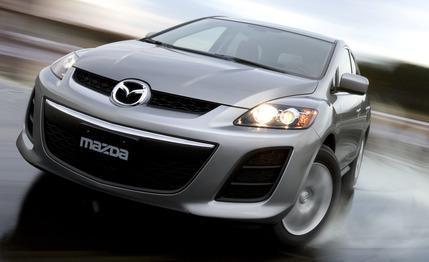 First Drive Review
First Drive Review
More for less obviously sounds like a good thing, but it also sets off alarm bells: What’s the catch?
The CX-7 crossover debuted in 2006 and quickly won praise from Car and Driver for its style, respectable power, and road manners worthy of Mazda's Zoom-Zoom tagline. One of the few elements that seemed to need attention, other than a bit more refinement, was pricing, which could be perceived as a little high versus the base models of key competitors such as the Hyundai Sante Fe and Dodge Journey.
That was because the CX-7’s lone powerplant—a turbocharged and intercooled 2.3-liter four—is a more expensive source of propulsion than a naturally aspirated engine.
The 2.5-Liter Solution
Mazda’s response to this problem is a broadened CX-7 range for 2010 that starts with a naturally aspirated 2.5-liter four lifted from the Mazda 6 sedan’s engine room. Mated to a five-speed automatic and available with front-wheel drive only, it’s a reasonably smooth operator. But more important, it’s easier on the pocketbook—the base price for the entry-level CX-7 is now $22,300, down $2350 from the bottom of the all-turbo lineup in 2009, and that’s amplified by better fuel economy. The EPA estimates 20 mpg city/28 highway for the 2.5 on regular fuel, compared with 18/25 for the front-drive turbo and 17/23 for the top-of-the-line all-wheel-drive models—and the turbo models are even thriftier than last year’s. Even though the CX-7's footprint is still closer in size to that of the Ford Edge and Nissan Murano, both of which are slightly more expensive than the turbocharged Mazda, the new four-cylinder brings the CX-7's sticker more in line with the base prices of smaller utes such as the Honda CR-V and Toyota RAV4.
Less Zoom-Zoom
That’s all good, of course, but what’s that catch to which we were referring? It has to do with your expectations relative to Mazda’s marketing mantra. If you’re expecting haste, this is not the right setup. The 2.5 generates 161 hp and 161 lb-ft of torque compared with the turbo’s 244 hp and 258 lb-ft. Although it’s lighter—Mazda lists the curb weight at just under 3500 pounds versus almost 3800 pounds for the front-drive turbo version—that’s a big power disparity, and it adds up to leisurely acceleration.
On the other hand, even though the 2.5 models are equipped with soft-riding 70-series tires on 17-inch alloy wheels (turbo models offer 18- and 19-inch wheels with lower profile rubber), responses are prompt by the standards of this class, with steering that delivers better-than-average road feel. Maybe that’s not particularly zoomy, but there are other benefits. For example, the ride quality is a shade better than in the turbo editions, and interior noise levels are distinctly lower.
Face-Lift Facts
Besides the new powertrain and reduced price point, the CX-7 gets some modest exterior freshening for 2010—a revised front fascia with a new grille and fog-light treatments and a redesigned rear bumper—but the more visible updates are inside. Splashes of chrome trim brighten the appearance of the dashboard, and upgraded upholstery materials (both cloth and leather), a new steering wheel, and revised gauges elevate the quality of the interior.
Safety is obviously an important factor in a vehicle likely to see family duty, and the CX-7 scores well in this area. Although all-wheel drive is available only on the turbo models, all versions include stability and traction control as standard, and the CX-7 gets five-star front- and side-impact NHTSA crash ratings.
The 2010 line is on sale now. As noted, the base 2.5 i SV model starts at $22,300. The better-equipped i Sport model, also powered by the 2.5, is $23,090, and a turbocharged front-drive s Touring model starts at $26,550 (add $1700 for all-wheel drive). The top-of-the-line s Grand Touring version begins at $31,935 with front-drive and $33,635 with all-wheel drive.